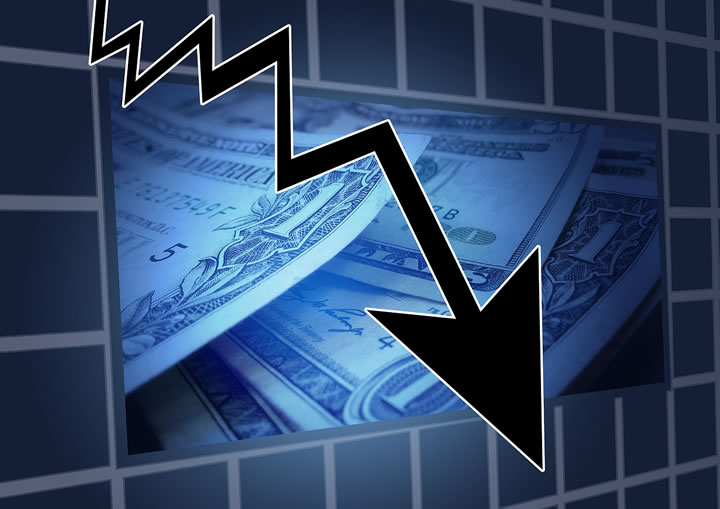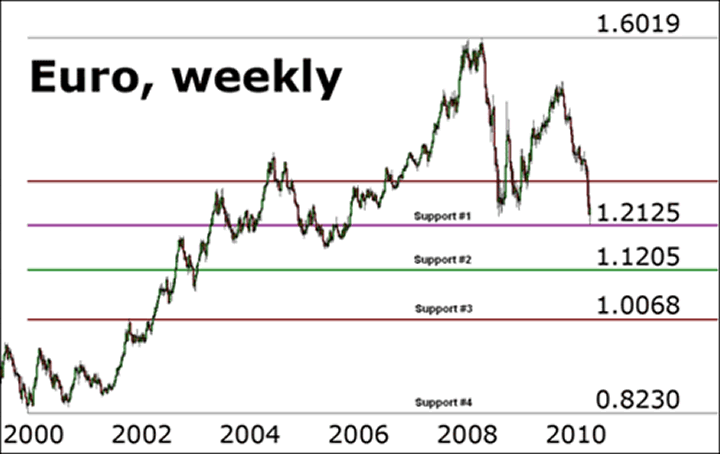Massive Currency and Debt Devaluations Lie Ahead
Currencies / Global Debt Crisis May 22, 2010 - 12:07 PM GMTBy: Bryan_Rich
 The run-up in the stock market from March 2009 until last month was sharp and rewarding … for some. But there was one problem, it came with disproportional risk. You see, the stock market rose to an extent that it was pricing in perfection … a V-shaped recovery … a return to normal.
The run-up in the stock market from March 2009 until last month was sharp and rewarding … for some. But there was one problem, it came with disproportional risk. You see, the stock market rose to an extent that it was pricing in perfection … a V-shaped recovery … a return to normal.
That overly optimistic view on the world can make for an ugly ending …
Because if there’s one thing we can assume after enduring a global meltdown of historical proportions, it’s this: A sharp return to normal is highly unlikely.
That common sense approach to risk aversion should be clear. And it’s why I find it troubling that stock market professionals have been scrambling to explain the recent decline in global stocks and other high risk investments.
They tell themselves, “This is just a healthy correction … earnings momentum is strong … the fear weighing on stocks is unwarranted.”
Then they quietly ask, “Is there something bigger going on?”
The answer: Of course there’s something big going on! And it’s sitting right under their nose, plain as day.
It’s a sovereign debt crisis, which is putting the world’s largest collective economy, the euro zone, in jeopardy.
And It’s Not Just Europe …
People around the globe should have gotten the wake-up call from the crisis in Europe. But denial is a strong emotion to overcome, especially for the stock market bulls that make a living from rising stocks.
 |
| Greece’s problems are spreading around the world. |
As I’ve warned in several Money and Markets columns, the problems in Greece aren’t just a European problem. Greece’s troubles have not only exposed the structural flaws of the European Monetary Union, but have also exposed the structural problems in the global economy.
Government officials around the world have attempted to put problems on hold for the time being, with the hope that they can deal with them later under better circumstances, when economies are stronger. They’ve responded to the debt problem by adding more debt. And that “crisis response” has only exacerbated a dynamic that created the crisis to begin with: Easy credit … i.e. debt.
We have benchmarks on how this likely turns out …
Historically, financial crises typically lead to sovereign debt crises. And sovereign debt crises typically lead to currency crises. All this is a recipe for tough economic times ahead.
Sovereign Debt Crisis Paving the Road for the Currency Crisis
The sovereign debt crisis is still unfolding. And a currency crisis is now upon us. When Europe chose to go all-in by pledging backstops for the downward spiraling weak countries within the euro zone, they made a conscious decision to devalue the euro and to inflate away the debt.
For those like the euro zone, which are backed into a corner, a currency and debt devaluation become the only option.
And with economies around the globe burdened with debt, addressing problems through currency devaluation becomes highly competitive.
You see, currencies are only valued on a relative basis, that means someone’s currency has to win the least ugly contest, and as a result appreciate against world currencies … in this case, it’s the U.S. dollar.
Meanwhile, three out of four of the most liquid currencies in the world — the euro, the pound and the yen — will likely be dramatically devalued before it’s all said and done.
As for the euro, many have been throwing around the possibility of the euro going to parity against the dollar.
Let’s take a look at my chart below to see just how low it can go …

The euro broke an eight-year trendline two weeks ago. It then retested that line last week following the announcement of the Emu stabilization plan, and it promptly failed.
This week, the recent downtrend in the euro breached the 2008 lows of 1.2330, a significant technical development.
Now we have the guidance of technical support levels that plot retracement points from the euro’s move off of the all-time highs of 2009 (1.60) to the all-time lows of 2000 (82 cents) …
- Support #1, the 50 percent retracement level, tested this week … and held, so far.
- The next support level comes in at 1.1205 (Support #2).
- And then parity to the dollar comes into the picture (Support #3).
Don’t expect the euro to decline in a straight line. The European Central Bank wants the decline to be orderly, and will likely be intervening at levels along the way to slow the pace.
The Organisation For Economic Co-Operation And Development (OECD) puts a fair value on the euro at about $1.16 based on purchasing price parity. But in times of stress, financial markets and currencies are known to overshoot.
The Big Picture …
To get an idea of where financial markets are headed, it’s important to have a good grasp of the big picture, perhaps never more important than today.
For that analysis, I’d like to revisit an IMF study on 122 historical recessions. This study found that recessions that are global and synchronized with financial crisis tend to have slower recoveries than average recessions, typically running about five years before long-term trend economic growth resumes.
 |
| Considering the structural problems surrounding the global economy, we could be in another storm. |
As an investor, that should give you a perspective on where we stand in the current downturn …
If you mark December 2007 as the beginning of the U.S. recession, we’re just half way through it.
Although economies are growing again, it’s highly probable that what we’re seeing now is just the calm before another storm. Or it’s a stimulus-induced surge off of low levels of economic activity that quickly deflates back into economic malaise.
Given the structural problems the global economy is facing, the “storm” scenario is most likely … in fact, I would argue it’s already well underway.
Regards,
Bryan
P.S. For more in depth analysis on the currency markets and specific recommendations on how to both profit and protect yourself from the unfolding currency crisis, I’d love for you to join me in my monthly newsletter, World Currency Alert. For more details please click here.
This investment news is brought to you by Money and Markets. Money and Markets is a free daily investment newsletter from Martin D. Weiss and Weiss Research analysts offering the latest investing news and financial insights for the stock market, including tips and advice on investing in gold, energy and oil. Dr. Weiss is a leader in the fields of investing, interest rates, financial safety and economic forecasting. To view archives or subscribe, visit http://www.moneyandmarkets.com.
© 2005-2022 http://www.MarketOracle.co.uk - The Market Oracle is a FREE Daily Financial Markets Analysis & Forecasting online publication.



